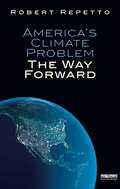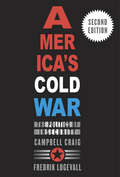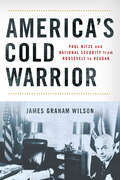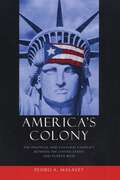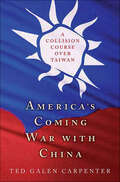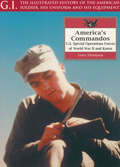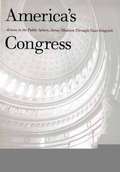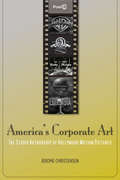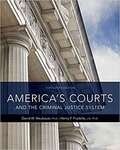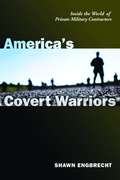- Table View
- List View
America's Civil War
by Brooks D. SimpsonBrief but thorough summarization of the history of the period, complete with an anotated biography.
America's Climate Choices
by Board on Atmospheric Sciences ClimateClimate change is occurring. It is very likely caused by the emission of greenhouse gases from human activities, and poses significant risks for a range of human and natural systems. And these emissions continue to increase, which will result in further change and greater risks. America's Climate Choices makes the case that the environmental, economic, and humanitarian risks posed by climate change indicate a pressing need for substantial action now to limit the magnitude of climate change and to prepare for adapting to its impacts. Although there is some uncertainty about future risk, acting now will reduce the risks posed by climate change and the pressure to make larger, more rapid, and potentially more expensive reductions later. Most actions taken to reduce vulnerability to climate change impacts are common sense investments that will offer protection against natural climate variations and extreme events. In addition, crucial investment decisions made now about equipment and infrastructure can "lock in" commitments to greenhouse gas emissions for decades to come. Finally, while it may be possible to scale back or reverse many responses to climate change, it is difficult or impossible to "undo" climate change, once manifested. Current efforts of local, state, and private-sector actors are important, but not likely to yield progress comparable to what could be achieved with the addition of strong federal policies that establish coherent national goals and incentives, and that promote strong U. S. engagement in international-level response efforts. The inherent complexities and uncertainties of climate change are best met by applying an iterative risk management framework and making efforts to significantly reduce greenhouse gas emissions; prepare for adapting to impacts; invest in scientific research, technology development, and information systems; and facilitate engagement between scientific and technical experts and the many types of stakeholders making America's climate choices.
America's Climate Problem: The Way Forward
by Robert RepettoWhat America does - or fails to do - in the next few years to solve the problem of climate change will largely determine the fate of the earth and humanity for centuries to come. Despite the efforts by some states, local governments and individual citizens to respond, controversy still embroils national efforts to come up with a solution. This book by Robert Repetto, a leading environmental economist, lets the reader cut through the confusion and political rhetoric and understand the way to resolve the climate problem. It explains in clear, accessible language how a sensible national policy to reduce greenhouse gas emissions can bring about a transition to clean energy sources while preserving healthy economic growth and high standards of living. It shows where the pitfalls are in developing a climate solution, how they can be avoided, and how to bring resistant interest groups on board. America cannot act alone but other nations will not take action if the United States does not lead, and this book explains how America can successfully promote international cooperation on climate solutions. Never has there been an environmental problem of such importance. Every citizen will benefit from the insight this book provides in solving it successfully.
America's Cold War: The Politics of Insecurity, Second Edition
by Fredrik Logevall Campbell Craig“A creative, carefully researched, and incisive analysis of U.S. strategy during the long struggle against the Soviet Union.” —Stephen M. Walt, Foreign Policy “Craig and Logevall remind us that American foreign policy is decided as much by domestic pressures as external threats. America's Cold War is history at its provocative best.” —Mark Atwood Lawrence, author of The Vietnam War The Cold War dominated world affairs during the half century following World War II. America prevailed, but only after fifty years of grim international struggle, costly wars in Korea and Vietnam, trillions of dollars in military spending, and decades of nuclear showdowns. Was all of that necessary? In this new edition of their landmark history, Campbell Craig and Fredrik Logevall include recent scholarship on the Cold War, the Reagan and Bush administrations, and the collapse of the Soviet regime and expand their discussion of the nuclear revolution and origins of the Vietnam War to advance their original argument: that America’s response to a very real Soviet threat gave rise to a military and political system in Washington that is addicted to insecurity and the endless pursuit of enemies to destroy. America’s Cold War speaks vividly to debates about forever wars and threat inflation at the center of American politics today.
America's Cold Warrior: Paul Nitze and National Security from Roosevelt to Reagan
by James Graham WilsonIn America's Cold Warrior, James Graham Wilson traces Paul Nitze's career path in national security after World War II, a time when many of his mentors and peers returned to civilian life. Serving in eight presidential administrations, Nitze commanded White House attention even when he was out of government, especially with his withering criticism of Jimmy Carter during Carter's presidency. While Nitze is perhaps best known for leading the formulation of NSC-68, which Harry Truman signed in 1950, Wilson contends that Nitze's most significant contribution to American peace and security came in the painstaking work done in the 1980s to negotiate successful treaties with the Soviets to reduce nuclear weapons while simultaneously deflecting skeptics surrounding Ronald Reagan. America's Cold Warrior connects Nitze's career and concerns about strategic vulnerability to the post-9/11 era and the challenges of the 2020s, where the United States finds itself locked in geopolitical competition with the People's Republic of China and Russia.
America's Colony: The Political and Cultural Conflict between the United States and Puerto Rico (Critical America #43)
by Pedro A MalavetThe precise legal nature of the relationship between the United States and the people of Puerto Rico was not explicitly determined in 1898 when the Treaty of Paris transferred sovereignty over Puerto Rico from Spain to the United States. Since then, many court cases, beginning in 1901, have been instrumental in defining this delicate relationship.While the legislation has clearly established the nonexistence of Puerto Rican nationhood and lack of independent Puerto Rican citizenship, the debate over Puerto Rico's status continues to this day.Malavet offers a critique of Puerto Rico’s current status as well as of its treatment by the U.S. legal and political systems. Puerto Rico is a colony of the United States, and Puerto Ricans living on this geographically separate island are subject to the United States’s legal and political authority. They are the largest group of U.S. citizens currently living under territorial status. Malavet argues that the Puerto Rican cultural nation experiences U.S. imperialism, which compromises both the island's sovereignty and Puerto Ricans’ citizenship rights. He analyzes the three alternatives to Puerto Rico's continued territorial status, examining the challenges manifest in each possibility, as well as illuminating what he believes to be the best course of action.
America's Comfort Foods
by Gooseberry PatchAmerica's best-loved comfort foods...over 200 unforgettable dishes from cooks coast to coast. You&’ll find recipes for regional favorites like Philly cheesesteaks, Chicago deep-dish pizza, classic midwestern meat loaf, Kansas City ribs, southern fried chicken, Tex-Mex enchiladas, all-American apple pie and much, much more! From breakfast to dinnertime, with these family-pleasing recipes you'll be serving up meals that warm tummies and hearts alike...snacks and desserts too!
America's Coming War with China: A Collision Course over Taiwan
by Ted Galen CarpenterOne issue could lead to a disastrous war between the United States and China: Taiwan. A growing number of Taiwanese want independence for their island and regard mainland China as an alien nation. Mainland Chinese consider Taiwan a province that was stolen from China more than a century ago, and their patience about getting it back is wearing thin. Washington officially endorses a "one China" policy but also sells arms to Taiwan and maintains an implicit pledge to defend it from attack. That vague, muddled policy invites miscalculation by Taiwan or China or both. The three parties are on a collision course, and unless something dramatic changes, an armed conflict is virtually inevitable within a decade. Although there is still time to avert a calamity, time is running out. In this book, Carpenter tells the reader what the U.S. must do quickly to avoid being dragged into war.
America's Commandos: U.S. Special Operations Forces of World War II and Korea (G.I.)
by Leroy ThompsonA photographic history of elite units in WWII and Korea, including uniforms, equipment, and more. America deployed a diverse group of special operations forces (SOF) throughout World War II and in Korea. These elite units quickly earned a redoubtable reputation and proved themselves adept at hit-and-run raids, gathering intelligence in long range patrols, rescuing POWs, and living and fighting in hostile environments. This valuable study includes more than 100 rare and unusual photographs of the men, uniforms, special equipment, and insignia of these elite troops, accompanied by informative captions. Units covered include the Marine Raider regiments and Paramarines, Ranger battalions, &“Merrill&’s Marauders,&” the Special Service Force, OSS teams, Naval CDUs, and ski and mountain troops. America&’s Commandos is a key addition to the G.I. Series and examines some of America&’s most feared and capable elite forces.
America's Commitment To Culture: Government And The Arts
by Kevin V MulcahyRobert Mapplethorpe and Andres Serrano are now legendary, as much because of NEA support of their work as for the work itself. This is one example of what can happen when politics meets culture, and it provides an appropriate snapshot of the issues explored in this book. As in other policy areas, cultural policies develop within a particular political context, evolve as a consequence of government action or inattention, and affect a variety of publics and interests. In this volume, the contributors explore the inescapable politics accompanying public culture. Surveying the philosophical, economic, legal, and political underpinnings of cultural assistance, they articulate not only governments role in the support of the arts, but also basic questions for future cultural policy. Robert Mapplethorpe and Andres Serrano are now legendary, as much because of NEA support of their work as for the work itself. This is one example of what can happen when politics meets culture, and it provides an appropriate snapshot of the issues explored in this book. As in other policy areas, cultural policies develop within a particular political context, evolve as a consequence of government action or inattention, and affect a variety of publics and interests.Americas Commitment to Culture discusses government support of culture as a public policy area. The book focuses on the rationales underlying public support for the arts and examines the development and practice of government as an arts patron. The contributors explore the inescapable politics accompanying public culture. Surveying the philosophical, economic, legal, and political underpinnings of cultural assistance, they articulate not only governments role in the support of the arts, but also basic questions for future cultural policy.
America's Communal Utopias
by Donald E. PitzerFrom the Shakers to the Branch Davidians, America's communal utopians have captured the popular imagination. Seventeen original essays here demonstrate the relevance of such groups to the mainstream of American social, religious, and economic life. The contributors examine the beliefs and practices of the most prominent utopian communities founded before 1965, including the long-overlooked Catholic monastic communities and Jewish agricultural colonies. Also featured are the Ephrata Baptists, Moravians, Shakers, Harmonists, Hutterites, Inspirationists of Amana, Mormons, Owenites, Fourierists, Icarians, Janssonists, Theosophists, Cyrus Teed's Koreshans, and Father Divine's Peace Mission. Based on a new conceptual framework known as developmental communalism, the book examines these utopian movements throughout the course of their development--before, during, and after their communal period. Each chapter includes a brief chronology, giving basic information about the group discussed. An appendix presents the most complete list of American utopian communities ever published. The contributors are Jonathan G. Andelson, Karl J. R. Arndt, Pearl W. Bartelt, Priscilla J. Brewer, Donald F. Durnbaugh, Lawrence Foster, Carl J. Guarneri, Robert V. Hine, Gertrude E. Huntington, James E. Landing, Dean L. May, Lawrence J. McCrank, J. Gordon Melton, Donald E. Pitzer, Robert P. Sutton, Jon Wagner, and Robert S. Weisbrot.
America's Competitive Secret
by Judy B. RosenerThe United States has a large number of well educated, experienced professional women ready, willing and able to move into the boardrooms and executive suites of corporate America. Together they represent a great, untapped economic resource, a resource no other country in the world can claim.This is America's competitive secret, argues Judy B. Rosener in this refreshingly pragmatic new book for managers who want to improve their bottom line. A leading expert on women and men at work and a highly sought-after speaker, Rosener argues that not only are men and women different, so are male and female managers. Drawing on in-depth interviews with top-flight executives and middle managers and the latest research on working women andorganizational change, she describes the unique contribution of female professionals. Her profiles of top women managers reveal that they cope well with ambiguity, are comfortable sharing power, and they tend to empower others-- leadership traits that Rosener contends lead to increased employeeproductivity, innovation, and profits. As businesses today struggle with corporate reorganization and an increasingly diverse workforce, America's Competive Secret offers compelling evidence that the changes that help organizatiions more fully utilize the talents of women are the same changes thatwill give them an important edge in today's fast-changing, service oriented, global workplace. Rosener explains why the so-called glass ceiling still prevents many competent women from reaching the upper echelons of management. She analyzes why women and men are perceived and evaluated differently at work, and provides new insight into the feelings of men who are asked to interact with womenin new roles when there are few new rules. Rosener shows that removing the glass ceiling can no longer be viewed solely in terms of social equity--it is now an economic imperative. Too many American businesses have limited their economic strength by viewing the promotion of women employees only within the context of federally mandated affirmative action laws and policies. America's Competitive Secret redefines the issue for a new era, showing that America's most successfulcompetitive strategy is one that most effectively utilizes all its human resources.
America's Congress: Actions in the Public Sphere, James Madison Through Newt Gingrich
by David R. MayhewTo understand American politics and government, we need to recognize not only that members of Congress are agents of societal interests and preferences but also that they act with a certain degree of autonomy and consequence in the country’s public sphere. In this illuminating book, a distinguished political scientist examines actions performed by members of Congress throughout American history, assessing their patterns and importance and their role in the American system of separation of powers.David R. Mayhew examines standard history books on the United States and identifies more than two thousand actions by individual members of the House and Senate that are significant enough to be mentioned. Mayhew offers insights into a wide range of matters, from the nature of congressional opposition to presidents and the surprising frequency of foreign policy actions to the timing of notable activity within congressional careers (and the way that congressional term limits might affect these performances). His book sheds new light on the contributions to U.S. history made by members of Congress.
America's Congress: James Madison Through Newt Gingrich
by David R. MayhewTo understand American politics and government, we need to recognize that members of Congress are more than agents of societal interests and preferences -- they also act with some autonomy and consequence in the public sphere. In this illuminating book, a distinguished political scientist examines the actions of members of Congress throughout American history, assessing their patterns and importance and their role in the U. S. system of separation of powers.
America's Constitution: A Biography
by Akhil Reed AmarIn America's Constitution, one of this era's most accomplished constitutional law scholars, Akhil Reed Amar, gives the first comprehensive account of one of the world's great political texts. Incisive, entertaining, and occasionally controversial, this "biography" of America's framing document explains not only what the Constitution says but also why the Constitution says it. <p><p>We all know this much: the Constitution is neither immutable nor perfect. Amar shows us how the story of this one relatively compact document reflects the story of America more generally. (For example, much of the Constitution, including the glorious-sounding "We the People," was lifted from existing American legal texts, including early state constitutions.) In short, the Constitution was as much a product of its environment as it was a product of its individual creators' inspired genius. <p>Despite the Constitution's flaws, its role in guiding our republic has been nothing short of amazing. Skillfully placing the document in the context of late-eighteenth-century American politics, America's Constitution explains, for instance, whether there is anything in the Constitution that is unamendable; the reason America adopted an electoral college; why a president must be at least thirty-five years old; and why-for now, at least-only those citizens who were born under the American flag can become president. <p>From his unique perspective, Amar also gives us unconventional wisdom about the Constitution and its significance throughout the nation's history. For one thing, we see that the Constitution has been far more democratic than is conventionally understood. Even though the document was drafted by white landholders, a remarkably large number of citizens (by the standards of 1787) were allowed to vote up or down on it, and the document's later amendments eventually extended the vote to virtually all Americans. We also learn that the Founders' Constitution was far more slavocratic than many would acknowledge: the "three fifths" clause gave the South extra political clout for every slave it owned or acquired. <p>As a result, slaveholding Virginians held the presidency all but four of the Republic's first thirty-six years, and proslavery forces eventually came to dominate much of the federal government prior to Lincoln's election. <p>Ambitious, even-handed, eminently accessible, and often surprising, America's Constitution is an indispensable work, bound to become a standard reference for any student of history and all citizens of the United States. <p>[This text is listed as an example that meets Common Core Standards in English language arts in grades 11-12 at http://www.corestandards.org.]
America's Corporate Art: The Studio Authorship of Hollywood Motion Pictures (1929-2001)
by Jerome ChristensenContrary to theories of single person authorship, America's Corporate Art argues that the corporate studio is the author of Hollywood motion pictures, both during the classical era of the studio system and beyond, when studios became players in global dramas staged by massive entertainment conglomerates. Hollywood movies are examples of a commodity that, until the digital age, was rare: a self-advertising artifact that markets the studio's brand in the very act of consumption. The book covers the history of corporate authorship through the antithetical visions of two of the most dominant Hollywood studios, Warner Bros. and MGM. During the classical era, these studios promoted their brands as competing social visions in strategically significant pictures such as MGM's Singin' in the Rain and Warner's The Fountainhead. Christensen follows the studios' divergent fates as MGM declined into a valuable and portable logo, while Warner Bros. employed Batman, JFK, and You've Got Mail to seal deals that made it the biggest entertainment corporation in the world. The book concludes with an analysis of the Disney-Pixar merger and the first two Toy Story movies in light of the recent judicial extension of constitutional rights of the corporate person.
America's Courts And The Criminal Justice System
by David W. Neubauer Henry F. FradellaOpen this book and step into America's court system! With Neubauer and Fradella's best seller, you will see for yourself what it is like to be a judge, a prosecutor, a defense attorney, and more. This fascinating and well-researched book gives you a realistic sense of being in the courthouse, enabling you to quickly gain an understanding of what it is like to work in and be a part of the American criminal justice system. The book's approach, which focuses on the courthouse "players," makes it easy to understand each person's important role in bringing a case through the court process. Throughout the book, the authors highlight not only the pivotal role of the criminal courts but also the court's importance and impact on society as a whole.
America's Courts and the Criminal Justice System
by David W. Neubauer Henry F. FradellaOpen this book and step into America's court system! With Neubauer and Fradella's best-selling text, you'll get an inside view of the experiences of a judge, a prosecutor, a defense attorney, and more. <p><p> This fascinating and well-researched text gives you a realistic sense of being in the courthouse, enabling you to quickly grasp what it's like to work in and be a part of the American criminal justice system. The book's approach, which focuses on the courthouse "players," makes it easy to understand each person's important role in bringing a case through the court process. Throughout, the authors highlight not only the pivotal role of the criminal courts but also the court's importance and impact on society as a whole.
America's Courts and the Criminal Justice System, 10th Edition
by David W. Neubauer Henry F. FradellaOpen this book and step into America's court system! With Neubauer and Fradella's best-selling text, you will see for yourself what it is like to be a judge, a prosecutor, a defense attorney, and more. This fascinating and well-researched text gives you a realistic sense of being in the courthouse--you will quickly gain an understanding of what it is like to work in and be a part of the American criminal justice system. This concept of the courthouse "players" makes it easy to understand each person's important role in bringing a case through the court process. Throughout the text, the authors highlight not only the pivotal role of the criminal courts but also the court's importance and impact on society as a whole.
America's Covered Bridges
by Terry E. Miller A. Chester Ong Ronald G. KnappThe history of North America is in many ways encapsulated in the history of her covered bridges. The early 1800s saw a tremendous boom in the construction of these bridges, and in the years that followed as many as 15,000 covered bridges were built. Today, fewer than a thousand remain.Without covered bridges to span the rivers and provide access to vast swaths of the interior that had previously been difficult to access-America never would have developed the way she did. In America's Covered Bridges, authors Terry E. Miller and Ronald G. Knapp tell the fascinating story of these bridges, how they were built, the technological breakthroughs required to construct them, and above all the dedication and skill of their builders. Each of the bridges, whether still standing or long gone, has a story to tell about the nature of America at the time-not only about its transportational needs, but the availability of materials and the technological prowess of the people who built it.This book is absolutely packed with fascinating stories and information-passionately told by two leading experts on this subject. The book will be of tremendous interest to anyone interested in American history, carpentry and early technology.
America's Covered Bridges
by Terry E. Miller Ronald G. KnappThe history of North America is in many ways encapsulated in the history of her covered bridges. The early 1800s saw a tremendous boom in the construction of these bridges, and in the years that followed as many as 15,000 covered bridges were built. Today, fewer than a thousand remain. Without covered bridges to span the rivers and provide access to vast swaths of the interior that had previously been difficult to access-America never would have developed the way she did. In America's Covered Bridges, authors Terry E. Miller and Ronald G. Knapp tell the fascinating story of these bridges, how they were built, the technological breakthroughs required to construct them, and above all the dedication and skill of their builders. Each of the bridges, whether still standing or long gone, has a story to tell about the nature of America at the time-not only about its transportational needs, but the availability of materials and the technological prowess of the people who built it. This book is absolutely packed with fascinating stories and information-passionately told by two leading experts on this subject. The book will be of tremendous interest to anyone interested in American history, carpentry and early technology.
America's Covert Warriors: Inside the World of Private Military Contractors
by Shawn Engbrecht<p>Private military contractors, especially those in Iraq, have taken on far more than their original mandates required. Initially intended for combat support, they have become full-fledged warriors, many with little experience, scant oversight, and no accountability to the rules of engagement that constrain the U.S. military and coalition forces. When the occupation of Iraq turned into a fight against an insurgency, overwhelming U.S. and coalition military forces, the demand for private military contractors skyrocketed in 2003 and 2004. The explosive growth of such firms as Blackwater, Crescent, and others resulted in a relaxation of recruitment standards at precisely the same time that the U.S. military’s own standards of recruitment began to falter, but the standards for private military contractors fell much further and faster. The predictable result included excessive civilian casualties, a human tragedy whose full dimensions have yet to be seen by the American public. <p>Shawn Engbrecht has been training and recruiting private military contractors for more than a decade. Acknowledging that some private military contractors are out of control, he argues that the oft-made suggestion to fire them all is not the solution. Instead, Engbrecht contends that with proper training and development of recruits, along with enforceable regulation and oversight, private security companies can be successfully integrated into a total force package with a professional operational staff.</p>
America's Cultural Revolution: How the Radical Left Conquered Everything
by Christopher F. RufoAN INSTANT NEW YORK TIMES, USA TODAY, AND AMAZON BESTSELLER America’s most effective conservative intellectual proves once and for all that Marxist radicals have taken over our nation's institutions.In the 1960s, Mao launched China’s Cultural Revolution. Cities grew overcrowded. Technocrats demanded progress from above. Anyone opposed was sent to be “re-educated.” China’s revolution was bloody, fast, and a failure, but what if America started a revolution at the same time, based on the same bad ideas, and it’s just been slower, calmer, and more effective?In his powerful new book, Christopher F. Rufo uncovers the hidden history of left-wing intellectuals and activists who systematically took control of America’s institutions to undermine them from within. America’s Cultural Revolution finally answers so many of the questions normal Americans have, such as:• Why is nearly every major corporation bending the knee to a far-left agenda?• How did DEI suddenly become the department no institution can continue without?• Why is race the main thing America’s rich, white elite wants to talk about? • When did the left adopt all this doublespeak, saying progress is a lack of progress, equality is not equality, speech is violence, and violence is speech?• Has the goal of the left, for a century, actually been the destruction of every Western institution? Readers may not know the names of Herbert Marcuse, Angela Davis, Paulo Freire, and Derrick Bell, but they will recognize the ideas they spread. How their radical, destructive ideology slowly worked its way from prisons to academia to classrooms to your human resources department will come as a shock.Failing to act soon, Rufo warns, could allow the radical left to achieve their ultimate objective: replacing constitutional equality with a race-based redistribution system overseen by bureaucratic ‘diversity and inclusion’ officials. Most Americans don’t want this, but most Americans are no longer in control of our institutions. If the mainstream media’s depiction of a failing dystopia in need of a fresh start never sounded right to you, this expose and call to arms is the book you’ve been looking for.
America's Culture of Terrorism
by Jeffory A. ClymerAlthough the terrorist attacks of 11 September 2001 shocked the world, America has confronted terrorism at home for well over a century. With the invention of dynamite in 1866, Americans began to worry about anonymous acts of mass violence in a way that differed from previous generations' fears of urban riots, slave uprisings, and mob violence. Focusing on the volatile period between the 1886 Haymarket bombing and the 1920 bombing outside J. P. Morgan's Wall Street office, Jeffory Clymer argues that economic and cultural displacements caused by the expansion of industrial capitalism directly influenced evolving ideas about terrorism.In America's Culture of Terrorism, Clymer uncovers the roots of American terrorism and its impact on American identity by exploring the literary works of Henry James, Ida B. Wells, Jack London, Thomas Dixon, and Covington Hall, as well as trial transcripts, media reports, and the cultural rhetoric surrounding terrorist acts of the day. He demonstrates that the rise of mass media and the pressures of the industrial wage-labor economy both fueled the development of terrorism and shaped society's response to it. His analysis not only sheds new light on American literature and culture a century ago but also offers insights into the contemporary understanding of terrorism.
America's Cup Yachts, The: The Rhode Island Connection
by Richard V. SimpsonThe dominance of the New York Yacht Club, in possession of the America's Cup between 1851 and 1983, has given Newport, Rhode Island, the status of yachting capital of the world. Seven of the most respected America's Cup defenders were built in Bristol, Rhode Island. The state's contribution to racing yacht technology began in Bristol, when N.G. Herreshoff designed and built the Vigilant in 1893. The Goetz Custom Sailboat Company continues the Bristol tradition of building superior sailing vessels, many of which have been challengers for the coveted America's Cup, beginning with the America 3 in 1992. In his sixth volume for the Images of America series, author Richard V. Simpson explores the allure of the America's Cup yachts and racing through more than 200 images from his own diverse collection. The photographs focus on the beauty and dignity of the yachts, the genius of engineering minds, and the handiwork of skilled crafters. Within these pages, view a variety of rare images captured by turn-of-the-century biograph and stereoscopic cameras, and experience the majestic dance of the yachts as they jockey for position, from the starting gun to the crossing of the finish line.


